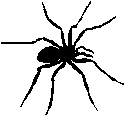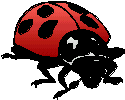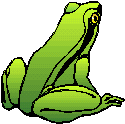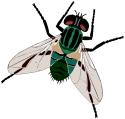Biocontrol Agents
Insects are their own worst enemies. The predators and parasites (or parasitoids) of other insects include members of over 300 families in 10 insect orders. Insects also serve as prey for other arthropods (particularly spiders and mites), and several groups of vertebrates (e.g., fish, birds, frogs, toads, bats, mice, shrews, and of course anteaters!). Insects are parasitized by various types of roundworms (nematodes) and are also attacked by a diverse group of pathogens including fungi, protozoa, rickettsiae, bacteria, and viruses. The following list includes some of the more important groups of natural enemies.
Predators
Arthropods

Spiders (order Aranea) — All spiders (nearly 4000 species) are predators, and insects represent well over 99% of their diet. Despite their abundance, spiders play a relatively minor role in biological pest control because their diet is so non-selective.
Dragonflies (order Odonata) — Adults as well as immatures are predatory. Adult dragonflies can have a significant impact on populations of mosquitoes and other small flying insects. (One specimen caught in 1917 by R. J. Tillyard had more than 100 mosquitoes crammed in its mouth and could not even close its jaws!)
Lacewings (order Neuroptera) — Larval stages of all neuroptera are voracious predators. Immature lacewings are known as aphis-lions (Chrysopidae). They have hollow, sickle-shaped mandibles used to spear soft-bodied aphids and suck them dry. A single aphis-lion may consume as many as 30 or 40 aphids per day.
 Beetles (order Coleoptera) — Coccinellidae (lady beetles), Carabidae (ground beetles), and Cicindellidae (tiger beetles) are the most noteworthy families of predators. The lady beetles are effective predators of aphids and scale insects. A ground beetle, Calosoma sycophanta, was introduced into New England as a predator of gypsy moths.
Beetles (order Coleoptera) — Coccinellidae (lady beetles), Carabidae (ground beetles), and Cicindellidae (tiger beetles) are the most noteworthy families of predators. The lady beetles are effective predators of aphids and scale insects. A ground beetle, Calosoma sycophanta, was introduced into New England as a predator of gypsy moths.
Flies (order Diptera) — Immatures of the family Syrphidae (flower flies) and adults of the Asilidae (robber flies) are beneficial predators. Syrphid fly larvae feed mostly on aphids, consuming as many as 50 or 60 prey in one hour.
True Bugs (order Hemiptera) — Damsel bugs (Nabidae), minute pirate bugs (Anthocoridae), and big-eyed bugs (Lygaeidae) are important predators of Lepidopteran eggs and larvae. The families Reduviidae (assassin bugs) and Phymatidae (ambush bugs) are more opportunistic predators.

Ants and Wasps (order Hymenoptera) — Some species of ants, especially the fire ants and army ants (Formicidae) are aggressive and non-selective predators. Hunting wasps in the families Pompilidae, Vespidae, and Sphecidae provision their nests with spiders, caterpillars, or other small insects.
Thrips (order Thysanoptera) — Most thrips feed on plants, but a few species such as the black hunter (Leptothrips mali) and the banded thrips (Aeolothrips fasciatus) prey on small arthropods including mites, aphids, whiteflies, and other thrips.
Mantids (order Mantodea) — The praying mantids (Mantidae) are rather non-selective predators. The immature stages are cannibalistic so they are probably much less effective as pest control agents than their reputation suggests.
Vertebrates
Fish (class Pisces) — Aquatic insects serve as food for many kinds of fish. Several species of cyprinodont fish (e.g., Gambusia spp.) have been released as biocontrol agents of mosquito larvae.
 Frogs, Toads, and Salamanders (class Amphibia) — Insects are a large part of the diet for many species of amphibians. The giant toad, Bufo marinus, has been used to control white grubs in Puerto Rican sugarcane fields.
Frogs, Toads, and Salamanders (class Amphibia) — Insects are a large part of the diet for many species of amphibians. The giant toad, Bufo marinus, has been used to control white grubs in Puerto Rican sugarcane fields.
Lizards, Snakes, and Turtles (class Reptilia) — Many reptiles are general predators of insects and other small invertebrates. In some parts of the world, geckoes are kept as house pets to help reduce cockroach populations.
 Birds (class Aves) — Some birds, such as swifts, warblers, vireos, and flycatchers are almost exclusively insect predators. During nesting season, these birds typically make 200-300 trips per day in search of food. Around 1850, Mormon settlers in Utah were besieged by crickets that threatened to destroy their crops. Suddenly, thousands of seagulls appeared and ate most of the crickets. A monument was later erected in Salt Lake City, Utah to commemorate this flock of seagulls that saved the Mormon settlers from starvation.
Birds (class Aves) — Some birds, such as swifts, warblers, vireos, and flycatchers are almost exclusively insect predators. During nesting season, these birds typically make 200-300 trips per day in search of food. Around 1850, Mormon settlers in Utah were besieged by crickets that threatened to destroy their crops. Suddenly, thousands of seagulls appeared and ate most of the crickets. A monument was later erected in Salt Lake City, Utah to commemorate this flock of seagulls that saved the Mormon settlers from starvation.
Moles, shrews, mice, and bats (class Mammalia) — Soil-dwelling mammals are predators on white grubs and the pupal stages of many flies and moths. Bats (order Chiroptera) feed exclusively on small, flying insects. The little brown bat (Myotis lucifugus) may forage up to 30 miles away from home and eat more than half its weight in insects every night.
Parasites and Parasitoids
Arthropods
 Flies (order Diptera) — Tachinid flies (Tachinidae) are one of the largest and most beneficial families of Diptera. These flies attack larvae of Lepidoptera, Hymenoptera (sawflies), Coleoptera, and occasionally the nymphs of Orthoptera or Hemiptera. The Bombyliidae (bee flies) and Pipunculidae (big-headed flies) are also parasites of insect pests.
Flies (order Diptera) — Tachinid flies (Tachinidae) are one of the largest and most beneficial families of Diptera. These flies attack larvae of Lepidoptera, Hymenoptera (sawflies), Coleoptera, and occasionally the nymphs of Orthoptera or Hemiptera. The Bombyliidae (bee flies) and Pipunculidae (big-headed flies) are also parasites of insect pests.
Wasps (order Hymenoptera) — There are over 45 families of small to medium-sized wasps that parasitize other insects. The largest and most important of these families include the Braconidae, Ichneumonidae, Trichogrammatidae, Eulophidae, Encyrtidae, Aphelinidae, Chalcididae, Evaniidae, Scoliidae Pteromalidae, Mymaridae, Scelionidae, Mutillidae, Tiphiidae, Bethylidae, Chrysididae, Platygastridae, and Dryinidae.
Roundworms
 Nematodes (phylum Nematoda) — There are over 300 species of nematodes (in 19 families) that are known to attack insects. Most of the research in biological control, however, has focused on only two genera, Steinernema and Heterorhabditis. These nematodes are unique because they harbor symbiotic bacteria that are pathogenic to the nematode’s insect host.
Nematodes (phylum Nematoda) — There are over 300 species of nematodes (in 19 families) that are known to attack insects. Most of the research in biological control, however, has focused on only two genera, Steinernema and Heterorhabditis. These nematodes are unique because they harbor symbiotic bacteria that are pathogenic to the nematode’s insect host.
Pathogens
Fungi
 Although natural populations of insects are commonly attacked by fungal pathogens, there has been only limited success in using these organisms as biocontrol agents. In general, fungi are slow to kill their hosts. The fungal mycelium usually invades all body tissues and may eventually cause suffocation by blocking the tracheal system. Some fungal pathogens have a relatively broad host range (e.g., Beauveria bassiana, Metarhizium anisopliae, and Cordyceps spp.) while others are more narrowly adapted to specific hosts like aphids (e.g., Erynia radicans and Aschersonia spp.), muscoid flies (e.g., Entomophthora muscae), mosquito larvae (e.g., Lagenidium giganteum, Coelomomyces spp., and Tolypocladium spp.), or Lepidoptera (e.g., Nomuraea rileyi and Paecilomyces spp.).
Although natural populations of insects are commonly attacked by fungal pathogens, there has been only limited success in using these organisms as biocontrol agents. In general, fungi are slow to kill their hosts. The fungal mycelium usually invades all body tissues and may eventually cause suffocation by blocking the tracheal system. Some fungal pathogens have a relatively broad host range (e.g., Beauveria bassiana, Metarhizium anisopliae, and Cordyceps spp.) while others are more narrowly adapted to specific hosts like aphids (e.g., Erynia radicans and Aschersonia spp.), muscoid flies (e.g., Entomophthora muscae), mosquito larvae (e.g., Lagenidium giganteum, Coelomomyces spp., and Tolypocladium spp.), or Lepidoptera (e.g., Nomuraea rileyi and Paecilomyces spp.).
Protozoa
 Most species of entomopathic protozoa cause chronic infections that weaken, but do not kill their host. For this reason, there is little interest in these organisms as biocontrol agents. One notable exception is Nosema locustae, a microsporidian that has been mass-produced and marketed for control of grasshoppers under the trade name “Hopper Stopper”.
Most species of entomopathic protozoa cause chronic infections that weaken, but do not kill their host. For this reason, there is little interest in these organisms as biocontrol agents. One notable exception is Nosema locustae, a microsporidian that has been mass-produced and marketed for control of grasshoppers under the trade name “Hopper Stopper”.
Bacteria
 Most of the bacteria that are pathogenic to insects belong to the coccobacilli group. Members of the genus Bacillus are especially important as biological control agents. Some of these bacteria cause turbidity of body fluids (e.g., Bacillus popillae) and the diseases they cause have, therefore, come to be known as “milky” diseases. Other species form toxic protein crystals in conjunction with spore formation (e.g., Bacillus thuringiensis). Several strains of B. thuringiensis have been isolated and are now mass-produced and sold as pest control agents. Each strain has slightly different host specificity:
Most of the bacteria that are pathogenic to insects belong to the coccobacilli group. Members of the genus Bacillus are especially important as biological control agents. Some of these bacteria cause turbidity of body fluids (e.g., Bacillus popillae) and the diseases they cause have, therefore, come to be known as “milky” diseases. Other species form toxic protein crystals in conjunction with spore formation (e.g., Bacillus thuringiensis). Several strains of B. thuringiensis have been isolated and are now mass-produced and sold as pest control agents. Each strain has slightly different host specificity:
- B. thuringiensis kurstaki — lepidopterous larvae
- B. thuringiensis israelensis — mosquitoes and black flies
- B. thuringiensis san diego — some coleopteran larvae
Viruses
 The use of entomopathic viruses for insect control is still in its infancy. Many of these pathogens appear to have good potential as biocontrol agents because they are relatively host-specific. Viral-induced mortality is usually caused by toxic proteins that accumulate during the reproductive cycle of the virus. After death, the integument and the internal tissues typically “melt away” into a liquified blob. Most entomopathic viruses are grouped according to the type of “inclusions” found within infected cells:
The use of entomopathic viruses for insect control is still in its infancy. Many of these pathogens appear to have good potential as biocontrol agents because they are relatively host-specific. Viral-induced mortality is usually caused by toxic proteins that accumulate during the reproductive cycle of the virus. After death, the integument and the internal tissues typically “melt away” into a liquified blob. Most entomopathic viruses are grouped according to the type of “inclusions” found within infected cells:
NPV or CPV (Nuclear or Cytoplasmic Polyhedrosis Virus) — Clusters of virus particles are embedded within polyhedral inclusion bodies (crystals) that develop inside the nucleus or cytoplasm of infected cells. These are the most common viruses. They usually attack larvae of Lepidoptera or Hymenoptera (sawflies). The U.S. Forest Service has used NPVs as biocontrol agents for pine sawflies, tussock moths, and gypsy moths. There is also commercial interest in developing NPVs for use against corn earworms, cotton bollworms, cabbage loopers, and alfalfa butterflies.
Granulosis virus — Each virus particle is enclosed in its own protein coat, giving infected cells a “granular” appearance under high magnification. These pathogens typically infect the fat body in Lepidopteran larvae and pupae. A granulosis virus has been developed for use in apple orchards against larvae of the codling moth (Cydia pomonella).
Non-inclusion viruses — These pathogens (entomopox virus, for example) do not produce granules or polyhedral bodies. The cause of their toxicity is not well understood, but they are usually less virulent than other types of viruses.

